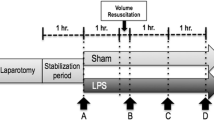Abstract
In order to examine the rate of lipid oxidation in sepsis, lipid infusion studies were carried out using two experimental models of septic rats, namely; an endotoxin group, and a cecum ligation and puncture group. Following the administration of glucose at a caloric amount equivalent to the measured resting energy expenditure (REE), the respiratory quotient (RG) values dropped promptly in the control group, but decreased only slightly in the septic groups. Following the administration of a lower dose of glucose (0.5 kcal/100 g B.W./hr), however, a lipid infusion promptly decreased the value of RQ in the septic groups. These results suggest that lipid oxidation was depressed in the septic groups and that the degree of depression was greatly influenced by the relationship between REE and the amount of administered glucose.
Similar content being viewed by others
References
Shaw JHF, Wolfe RR. Response to glucose and lipid infusion in sepsis: A kinetic analysis. Metabolism 1985; 34: 442–449.
Nanni G, Siegel JH, Coleman B, Fader P, Castiglione R. Increased lipid fuel dependence in the critically ill septic patient. J Trauma 1984; 24: 14–30.
Askanazi J, Carpentier YA, Elwyn DH, Nordenström J, Jeevanandam M, Rosenbaum SH, Gump FE, Kinney JM. Influence of total parenteral nutrition on fuel utilization in injury and sepsis. Ann Surg 1980; 191: 40–46.
Lanza-Jacoby S, Lansey SC, Cleary MP, Rosato FE. Alterations in lipogenic enzymes and lipoprotein lipase activity during gram-negative sepsis in the rat. Arch Surg 1982; 117: 144–147.
Chen WJ. Utilization of exogenous fat emulsion (intralipid) in septic rats. JPEN 1984; 8: 14–17.
Coran AG, Drongowski RA, Lee GS, Klein MO, Wesley JR. The metabolism of an exogenous lipid source during septic shock in the puppy. JPEN 1984; 8: 652–656.
Niwa H, Ogawa Y, Kido Y, Hirai K, Naruko M, Takahashi S, Kokunai I, Tane S, Takesawa J, Shimada Y, Nakajima Y, Hirai K, Mori T. A study on non-protein energy sources during TPN. The Japanese Journal of Surgical Metabolism and Nutrition 1984; 18: 354–355.
Niwa H, Ogawa Y, Kido Y, Tane S, Naruko M, Abe Y, Kobayashi M, Tachiyama G, Tanaka T, Mori T. Metabolic changes in septic models of rats. The Japanese Journal of Surgical Metabolism and Nutrition 1986; 19: 403–404.
Tanaka T, Kido Y, Fujiyama T, Ogawa Y, Kosaki G. Newly devised system of continuous measurement of gas exchange of small animals. The Japanese Journal of Surgical Metabolism and Nutrition 1980; 14: 72–73.
Kido Y, Ogawa Y, Boku K, Hara T, Hisstomi M, Takahashi S, Fujiyama T, Kawasaki K, Kosaki G, Tanaka T. A newly devised system of continuous measurement of gas exchange of small animals. The Japanese Journal of Surgical Metabolism and Nutrition 1981; 15: 168–169.
Naruko M, Ogawa Y, Kido Y, Niwa H, Abe Y, Kobayashi M, Mori T, Tanaka T. Studies on the energy expenditure following surgical stress: I. The effects of the severity of stress and the administration of nutrients. Jpn J Surg 1988; 18: 194–202.
Lusk G. Analysis of the oxidation of mixtures of carbohydrate and fat. J Biol Chem 1924; 59: 41.
Steiger E, Vars HM, Dudrick SJ. A technique for long-term intravenous feeding in unrestrained rats. Arch Surg 1972; 104: 330–332.
Clowes GHA, O’Donnell TF, Ryan NT, Blackburn GL. Energy metabolism in sepsis: Treatment based on different patterns in shock and high output stage. Ann Surg 1974; 179: 684–696.
Siegel JH, Cerra FB, Coleman BG, Giovannini I, Shetye M, Border JR, McMenamy RH. Physiological and metabolic correlations in human spesis. Surgery 1979; 86: 163–193.
Wichterman KA, Baue AE, Chaudry IH. Sepsis and septic shock—A review of laboratory models and proposal. J Surg Res 1980; 29: 189–201.
Fried RC, Bailey PM, Mullen JL, Stein TP, Crosby LO, Buzby GP. Alteration in exogenous substrate metabolism in sepsis. Arch Surg 1986; 121: 173–178.
Hirasawa H, Chaudry IH, Baue AE: Beneficial effect of ATP-MgCl2-glucose administration on survival following sepsis. Surg Forum 1978; 29: 11–14.
Wichterman KA, Irshad IH, Baue AE. Studies of peripheral glucose uptake during sepsis. Arch Surg 1979; 114: 740–745.
Author information
Authors and Affiliations
Rights and permissions
About this article
Cite this article
Niwa, H., Ogawa, Y., Kido, Y. et al. The rate of lipid oxidation in septic rat models. The Japanese Journal of Surgery 19, 439–445 (1989). https://doi.org/10.1007/BF02471625
Received:
Issue Date:
DOI: https://doi.org/10.1007/BF02471625




